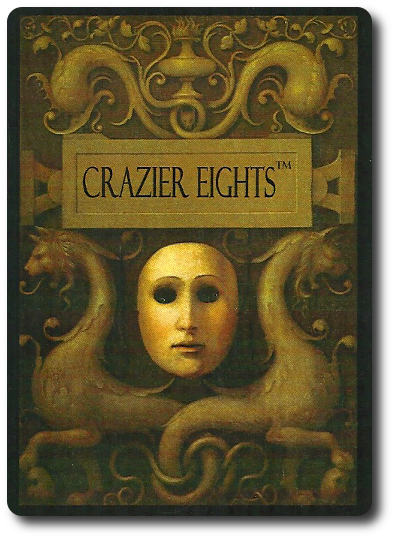
The Basics:
- For ages 10 and up (publisher suggests 13+)
- For 2 to 4 players
- Approximately 30 minutes to complete
Geek Skills:
- Counting & Math
- Logical & Critical Decision Making
- Reading
- Pattern/Color Matching
- Hand/Resource Management
Learning Curve:
- Child – Easy
- Adult – Easy
Theme & Narrative:
- A new twist on an old classic
Endorsements:
- Gamer Geek mixed!
- Parent Geek approved!
- Child Geek approved!
Overview
The heavenly bodies move like gears in a giant cosmic clock. From this, time is created, flows, and ends. We are swept up by the current of creation and destruction, the beginning and the end. Fate shuffles the deck and deals you a hand that determines what role you will play in this endless procession of moments. The only question is, do you accept what Fate has dealt you?
Crazier Eights, a self-published game designed by James Wallace Gray, is comprised of 4 suits of 13 cards for a total of 52 cards. Each card has beautiful artwork from such masters as John William Waterhouse, Thomas Cole, Virginia Frances Sterrett, and Vernet Horace just to name a few. The cards are made of thick card stock and are as durable as your standard playing card. Text and icons are in large, dark print making it easy to read. Those who have difficulty distinguishing colors should not have any problems playing this game thanks to the prominent display of each card’s suit and rank.
Game Set Up
To set up the game, first take the deck of cards and shuffle them.
Second, deal out to each player 7 cards, face-down.
Third, place the deck of cards face-down in the middle of the playing area. This is the draw deck for the duration of the game.
Fourth, flip over the top-most card from the draw deck and place it, face-up, next to the draw deck to create the discard pile.
That’s it for game set up. Determine who will be the first player and begin.
Card Anatomy
Each card in Crazier Eights uses the same layout, but will have different information. All cards will have a suit (Moons, Suns, Ankhs, or Eyes) and a rank (Ace, 2, 3, 4, 5, 6, 7, 8, 9, 10, Jack, Queen, or King). In this regard, the 52 cards in the game are like your standard playing card, save the different suits.
Unlike your standard playing card, each card in Crazier Eights is also an Event or an Asset. The card type is listed at the bottom of each card.
- Events trigger a one time effect resolved on the player’s turn
- Assets remain in the game until discarded
Additional information on each card includes the card’s name and suit color. The name of the card has no impact on game play. The card color is often used by players to quickly scan and organize their hand of cards and used to indicate the current card suit on the discard pile.
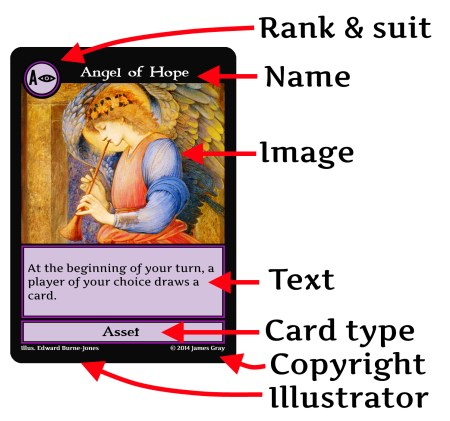
Image courtesy of craziereights.com
Note: There are copies of this game that contain promotional cards that break the standard rules. Since I wasn’t provided any to play with, I will not comment on their function.
A Typical Turn
Crazier Eights is played in turns with no set number of turns per game. On a player’s turn they will complete the following steps.
Step 1: Resolve Assets
If the player has played Assets that trigger at the beginning of their turn during the previous rounds, they should now resolve them in any order that makes sense to them.
Step 2: Draw 1 Card
The player now draws 1 card from the draw deck and adds it to their hand. If the draw deck is exhausted, take all but the top-most card from the discard pile and shuffle the cards. Place this pile of cards face-down as the new draw deck. The top-most card in the discard pile remains face-up.
Step 3: Resolve Additional Assets and Play One Asset or One Event
If there are more Assets in play that are triggered during the player’s turn (but not at the very start of it), they should now be resolved.
If the player wants to play a card for its Event or for its Asset, they can do it now or after step 3. Cards played for their Event or Asset DO NOT need to match the suit or rank of the top-most discarded card.
Step 4: Discard 1 Card
The player now attempts to discard 1 card from their hand to the discard pile. Cards played to the discard pile go on top and must match either the suit or rank of the top-most discarded card. The one exception to this rule is the “Crazy Eight”, from which the game derives its title. Any card with a rank of “8” is considered “Wild” and can be discarded to the top of the discard pile regardless of the suit and rank of the card below it. When placed, the player selects a new suit (color) that must now be played to. The rank does not change. The discard card can be played before step 3 if the player likes.
After the player has played their cards, the next player in turn order sequence now goes.
Events and Assets
Events and Assets are the player’s sword and shield in the game. They give the player the ability to defend against attacks and attack other players. They also give the player the ability to break rules and gain the advantage.
Events give the player a one-time ability or benefit during their turn that goes away as soon as their turn is over. Events include taking another turn, discarding 2 additional cards in 1 turn (which is not the same as 2 additional turns), and forcing a player to draw additional cards. When a player uses a card’s Event, it’s placed at the BOTTOM of the discard pile. Doing so does not change the top-most discarded card. In this way, players must decide if they want to use the card’s Event or if they want to change the suit or rank of the discard pile. They can’t do both.
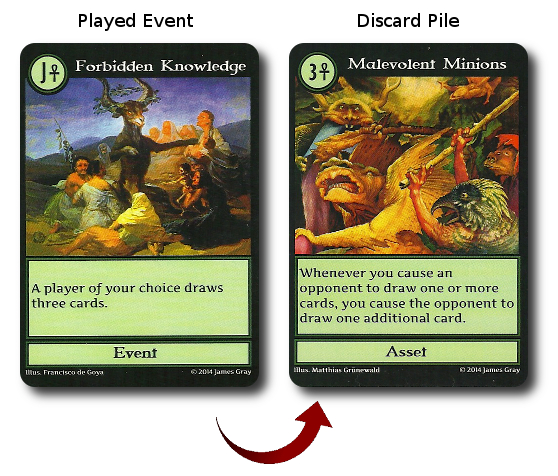
“Forbidden Knowledge” is played as an Event and goes underneath “Malevolent Minions”
Assets give the player a semi-permanent ability or benefit that is triggered during their turn. I say “semi-permanent” because there are cards that remove Assets from the game. This means a really great Asset won’t last long due to opponents taking it out. The best example of an Asset is the most powerful card in the game: “The Devious Dragon”. The dragon is the “wild 8” card in the game and can be used to change the color (suit) of the top-most discarded card, but only if it’s played to the discard pile. As an Asset, the card is placed in front of the player, face-up, and its effects can be triggered when the card states. In this case, “The Devious Dragon” eats (discards to the bottom) other cards in play. Including other dragons.
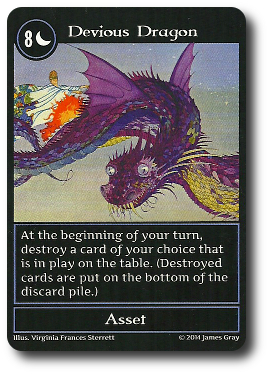
You’ll grow to hate/love this card…
In summary, cards can played to the discard pile are determined by suit and rank of the top-most discard card. This does not apply to cards that are played for Events and Assets. Events go to the bottom of the deck and Assets go in front of the player. Both Events and Assets do not alter the top-most card suit and rank of the discard pile.
Winning the Game
The first player to discard or play their last card from their hand wins the game.
Game Variants
Standard Card Games
Crazier Eights, other than the different suits and the lack of Jokers, is a normal 52 deck of playing cards. It can be used to play any other standard playing card game. For example, you could play Crazy Eights using Crazier Eights, which would allow younger Child Geeks to play the game.
Multiple Games
If more than one game is requested, each player receives 1 point per card they still have left in their hand at the end of the game. At the end of all the games, the player with the fewest points wins.
To learn more about Crazier Eights, visit the game’s website.
Prediction
Crazier Eights would appear to be a very simple game with some interesting twists. Basic hand management and critical thinking will play a role, but there are also some interesting combos that can be created. I think this will appeal to pretty much everyone we will sit down with. Although, similarities to UNO and Crazy Eights might give players an initial wrong impression.
I predict the Child and Parent Geeks will enjoy this game and be frustrated by it. They will enjoy the casual game play and the challenge of getting rid of cards. They will most likely become frustrated with the game if cards keep getting played for Events and Assets, never-changing the top-most discarded card, and forcing players to keep smacking each other rather than discarding cards. But that’s the game, so we cannot avoid it.
I have no idea what the Gamer Geeks are going to think about this game. I don’t think it’ll be approved, as the game is too light and is way too similar to easier card games. The Gamer Geeks will recognize Crazier Eights as a hybrid and not as a new game. But even hybrids have a way of taking games and gamers in new and exciting directions. Crazier Eights might just do that. What I don’t think it’ll do is fail. There is enough of a game here to keep a gaming elitist occupied and thinking. Just not for long and not deeply.
Teaching Crazier Eights is best done by simply going through a few card examples. We didn’t have any problems when teaching it. Just make sure you let players know where cards go when played as an Event, as an Asset, and to the discard pile. Note that players do need to be able to read in order to play Crazier Eights.
And so, after teaching this game to my oldest child geek, I asked him his thoughts on the game so far.
“Really cool artwork and I already know how to play this game!” ~ Liam (age 10)
My son makes a very good and important point. Any casual and elitist gamer will take one look at Crazier Eights and say, “Hey, this looks familiar.” Which makes for an easy and fast teaching session so you can jump into the game. Speaking of which, let’s get to it and see if Crazier Eights is a great hybrid or a boring offshoot.
Final Word
The Child Geeks jumped right in and had zero issues from the very first card to the very last. The game was immediately understood and mastered. And by “mastered” I mean they caused nothing but trouble for the other players with their Events and Assets. Ever see a Child Geek with a hungry dragon with a penchant to eat EVERY CARD ON THE TABLE? It’s a pain like no other. Especially when the other players can’t find a card to stop it. It was glorious. According to one Child Geek, “I really, really like this game! What I like best is the dragon!” Another Child Geek said, “I like the artwork. Especially the dragon.” OK, we get it. The Child Geeks love the dragon, but they also loved the game. Crazier Eights was approved by the Child Geeks.
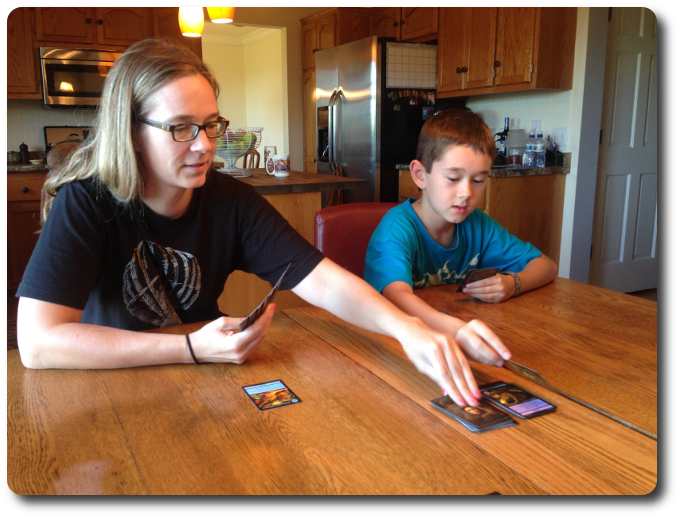
My son “thanks” his mom for making him eat his vegetables by forcing her to draw cards – lots of cards
The Parent Geeks didn’t really get the game at first until someone said, “Oh, it’s like UNO.” Then everything fell into place. The discarding to the bottom of the discard pile also threw the Parent Geeks at first. In fact, one Parent Geek said something very insightful. “Wait. If we keep discarding to the bottom of the discard pile, the top card will never change.” Bingo. A seemingly simple and “duh” statement, but in the heat of the game, players tend to play cards that will impact other players and not cards that will help them reduce their hand size. Another Parent Geek said, “This game is a keeper. I’m having a lot of fun with it.” As did all the Parent Geeks who voted to approve Crazier Eights.
The Gamer Geeks, as predicted, took one whiff of Crazier Eights and called it for what is was. According to one Gamer Geek, “So, this is just Crazy Eights with UNO like cards with a fantasy theme?” Well, yes. Not that the Gamer Geeks had a problem with that, mind you, but they just wanted to make sure they were looking at the game correctly. What they didn’t expect was the challenge the game provided. With Assets and Events flying around, winning the game was easier said than done. But this ended up hurting the game rather than helping it. According to one Gamer Geek, “This game stays way, way, way too long at the table.” Several times, Gamer Geeks would be very close to winning only to be bombarded with cards that caused them to draw more. This irritated a number of the Gamer Geeks and they started talking about how much they disliked Crazier Eights and UNO. One Gamer Geek said, “This is exactly why I don’t play UNO. It takes too long, is too random, and you can’ t do much to stop it.” That’s not true in Crazier Eights, as there are “Castle” cards that protect you from drawing more cards, but they never seemed to be around. Especially with the dragon. But there were also a number of Gamer Geeks who were really enjoying the game. According to one of these Gamer Geeks, “I like how you always have to draw 1 card and play 1 card per turn, but you have to manage your hand if you want to play an additional card and get ahead.” Another Gamer Geek said, “Subtle. That’s what I would say this game is. Very subtle. I’m enjoying it.” In the end, Crazier Eights pleased some game elitists as a casual and entertaining game that could be played as a filler and irritated other gaming elitists for reasons described above.
There are four personal points I want to leave you with regarding Crazier Eights.
First, Crazier Eights is really nothing like UNO, Crazy Eights, or even Magic: The Gathering (that a few of our players thought this game was similar to). It is a hybrid, however. One need not look very deep to see where this game derived most of its mechanics. Not a bad thing, but I don’t want to leave you with the impression that this is just a themed version of a free game you can play with a standard deck of cards. Crazier Eights is very much its own and unique game that is simply using tried and true mechanics in a new and interesting way.
Second, the ability to play any card for its Event and Asset regardless of its suit or rank feels way off when you have to play suit and rank to the discard pile. This had many of our players questioning why the discard pile was even necessary. In truth, it’s very important. Every player draws 1 card into their hand, increasing their total hand size by one. They can then play 1 card for its Event or Asset. This keeps the player’s hand the same size. However, each player can then discard 1 card if possible. This then allows the player to get closer to winning the game. Especially if they are able to discard more than 1 card per turn.
Third, it is impossible to win by simply playing Events and Assets. Players only get to play 1 card for its Assets or Event per turn. The key term here is “turn”. A player might be able to play a card that gives them an extra turn, but if they do, they are forced to draw 1 card at the beginning of their additional turns. As you can see, simply playing Assets and Events doesn’t bring the player closer to victory. In fact, it keeps them away from it.
Fourth, combos are everything. A smart player will start to see that stacking Assets and Events together can create some very interesting and potentially painful plays. For example, have “Malevolent Minions” Asset in play from the last turn and then play “Forbidden Knowledge” as an Event. This forces a player of your choice to draw 4 cards! Or, protect yourself against such an attack by using 4 “Castle” Assets to ensure no can add cards to your hand. If a player is crafty, they’ll see the subtle ways they can combo their cards to make each turn a great success.
The end result is a very interesting game where you are always adding cards to your hand and coming up with smart ways to get ride of them. All the while, the longer you stay in the game, the more cards you have to deal with. And if you don’t manage the discard pile, you will lose out on opportunities to get the upper hand. A very interesting and enjoyable game, Crazier Eights does a good job of mixing it up and dealing it out in a way that is both familiar and new. Do sit down for a game of Crazier Eights when the opportunity presents itself. Just be forewarned: here there be dragons. Stupid, card eating, dragon.
This game was given to Father Geek as a review copy. Father Geek was not paid, bribed, wined, dined, or threatened in vain hopes of influencing this review. Such is the statuesque and legendary integrity of Father Geek.




Pingback: Crazier Eights Review at Father Geek | Crazier Eights
Pingback: In Review: Father Geek’s Monthly Newsletter (September 2014) - Father Geek